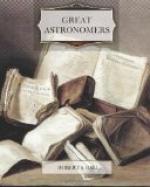One day when Bradley was out sailing he happened to remark that every time the boat was laid on a different tack the vane at the top of the boat’s mast shifted a little, as if there had been a slight change in the direction of the wind. After he had noticed this three or four times he made a remark to the sailors to the effect that it was very strange the wind should always happen to change just at the moment when the boat was going about. The sailors, however, said there had been no change in the wind, but that the alteration in the vane was due to the fact that the boat’s course had been altered. In fact, the position of the vane was determined both by the course of the boat and the direction of the wind, and if either of these were altered there would be a corresponding change in the direction of the vane. This meant, of course, that the observer in the boat which was moving along would feel the wind coming from a point different from that in which the wind appeared to be blowing when the boat was at rest, or when it was sailing in some different direction. Bradley’s sagacity saw in this observation the clue to the Difficulty which had so long troubled him.
It had been discovered before the time of Bradley that the passage of light through space is not an instantaneous phenomenon. Light requires time for its journey. Galileo surmised that the sun may have reached the horizon before we see it there, and it was indeed sufficiently obvious that a physical action, like the transmission of light, could hardly take place without requiring some lapse of time. The speed with which light actually travelled was, however, so rapid that its determination eluded all the means of experimenting which were available in those days. The penetration of Roemer had previously detected irregularities in the observed times of the eclipses of Jupiter’s satellites, which were undoubtedly due to the interval which light required for stretching across the interplanetary spaces. Bradley argued that as light can only travel with a certain speed, it may in a measure be regarded like the wind, which he noticed in the boat. If the observer were at rest, that is to say, if the earth were a stationary object, the direction in which the light actually does come would be different from that in which it appears to come when the earth is in motion. It is true that the earth travels but eighteen miles a second, while the velocity with which light is borne along attains to as much as 180,000 miles a second. The velocity of light is thus ten thousand times greater than the speed of the earth. But even though the wind blew ten thousand times faster than the speed with which the boat was sailing there would still be some change, though no doubt a very small change, in the position of the vane when the boat was in progress from the position it would have if the boat were at rest. It therefore occurred to this most acute of astronomers that when the telescope was pointed




